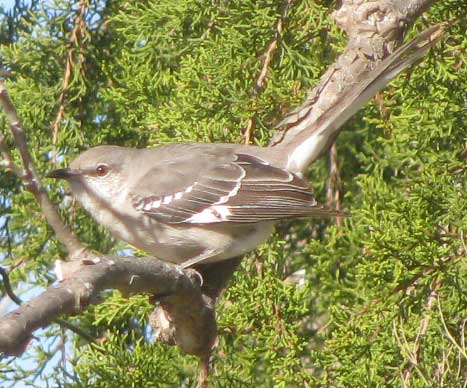Excerpts from Jim Conrad's
Naturalist Newsletter
from the February 2, 2014 Newsletter issued from the Frio Canyon Nature Education Center in the valley of the Dry Frio River in northern Uvalde County, southwestern Texas, on the southern border of the Edwards Plateau; elevation ~1750m (~5750 ft); N29.62°, W99.86°; USA
NORTHERN MOCKINGBIRD
Mockingbirds are common all across the southern two-thirds of the US, south through most of Mexico. Books call them Northern Mockingbirds to separate them from other mockingbird species farther south. They're MIMUS POLYGLOTTOS, the binomial neatly translating to "many-tongued mimic."
With regard to their mimicking, I can tell the story of how when I was a 15 year-old kid back on the farm in Kentucky, that summer I got my ham radio license and used Morse Code to talk with other hams all over the world. My radio shack was upstairs where it was hot, so the windows stayed open, and by the end of summer the mockingbird in the Flowering Peach just outside the window began adding Morse Code to his repertoire. He never said anything, of course, but he definitely sang properly spaced dits and dahs. Such a bird deserves its status as the state bird of Arkansas, Florida, Mississippi, Tennessee and Texas.
Around here mockingbirds are abundant year round, but they're not the laid-back feeder visitors I've known elsewhere. Here mockers are skittish, flying away when they see you. Note the wariness in the face of one shown below:

That bird is a lot paler and has much more white in its wing than birds I've been seeing both in the Yucatan and back East. In fact, three subspecies of the Northern Mockingbird are recognized, and this is the one I'm not used to. In the eastern US there's Mimus polyglottos polyglottos, and in the west Mimus polyglottos leucopterus. Texas has both the eastern and western subspecies.
In Texas the two subspecies intergrade in the eastern Edwards Plateau, near San Antonio, but we're in the western Plateau region, in the domain of the western subspecies. The Wikipedia mockingbird expert says that the western subspecies is larger than the eastern, but its tail is slightly shorter, its upperparts are more buff and paler, and its underparts are more buff, which is about what we see in our photograph. Also, the western subspecies' name "leucopterus" means "white-wing," referring to the big white splotch so prominent on our bird's wing.
In the Yucatan we had the Tropical Mockingbird, which my field guide called Mimus gilvus. Some experts lump that species with the Northern Mockingbird. You might enjoy comparing our pale mockingbird with a much darker winged Tropical Mockingbird photographed in Chiapas, Mexico's southernmost state, at http://www.backyardnature.net/chiapas/cenzontl.jpg.